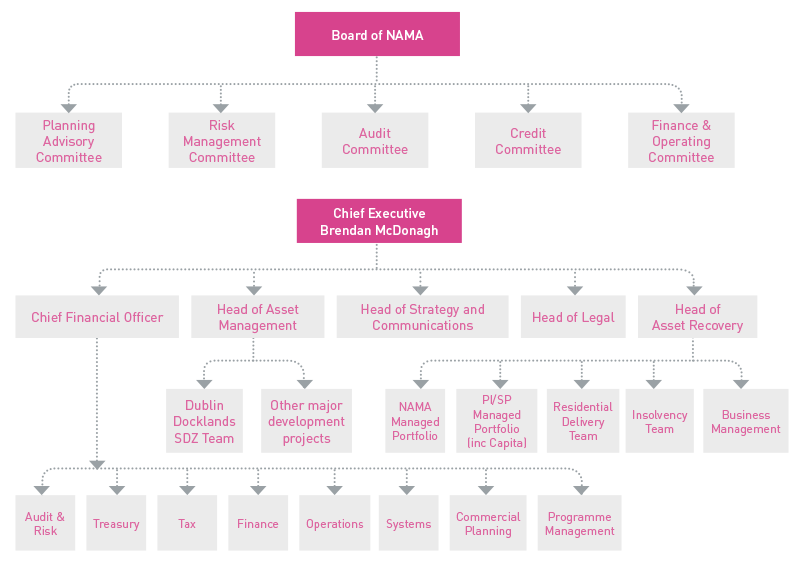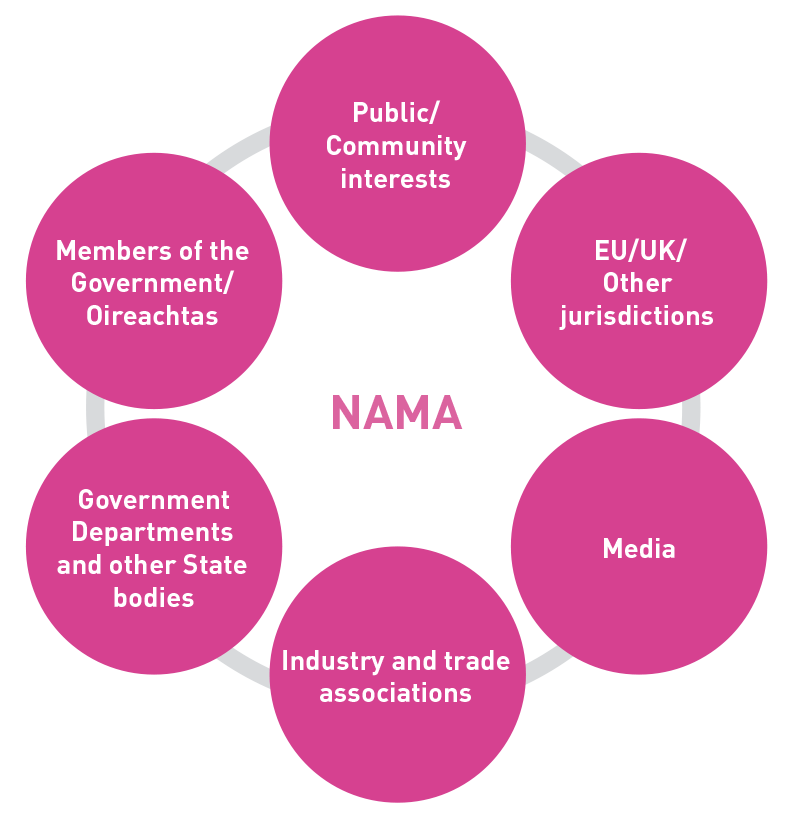Organisational Structure
NAMA, through the NTMA, has recruited staff with a diverse range of skills and experience from the disciplines of banking, finance, law, property (quantity surveyors, engineers), insolvency and planning, among others. NAMA is organised across five divisions (see Figure R below). NAMA’s structure continues to evolve as required: the Minister’s Section 227 review of NAMA expanded NAMA’s remit to (i) ensure the timely and coherent delivery of key Grade A office, retail and residential space within the Dublin Docklands SDZ and Dublin’s Central Business District and (ii) maximise the delivery of residential housing units in areas of most need. To this end NAMA established a dedicated Residential Delivery team (within the Asset Recovery division) in April 2014 and created within its Asset Management division a team solely focused on the development of the Dublin Docklands SDZ.
Staff resources
The number of NTMA staff assigned to NAMA was 369 at end-2014. Between inception and end-March 2015, 126 members of staff resigned, including 67 resignations during 2014.
Organisational Structure
FIGURE R: NAMA organisational structure as at 1 January 2015

ASSET RECOVERY
The Asset Recovery division which, at end-2014, comprised 193 staff, has a number of key functions: strategy delivery, management of debtors and receivers and maximising cashflow.
Asset Recovery is NAMA’s principal interface with debtors and receivers and is responsible for the management and oversight of over 99% of the debtor connections (by number); both those directly managed by NAMA and indirectly managed through Allied Irish Bank p.l.c. (‘AIB’) and Capita Asset Services (‘Capita’). This responsibility requires intensive daily management employing a range of workout methods including the following:
- Setting and actively monitoring clear strategies, targets and milestones.
- Minimising debtor and receiver costs.
- Securing and maximising income streams.
- Optimising sales values through proactive asset management.
- Providing additional capital expenditure funding where incremental value can be obtained or value protected.
- Executing sales of property portfolios or loans where appropriate.
- Reviewing, on a regular basis, asset sale versus asset hold options.
The structure of Asset Recovery continued to evolve in 2014 with the establishment of a dedicated Residential Delivery team to facilitate the delivery by NAMA debtors and receivers of 4,500 new residential units in the Greater Dublin Area by the end of 2016. In order to expedite the significant increase in property portfolio sales and loan sales which were planned and executed in 2014, the Transaction Team was expanded and split into a dedicated Loan Sales team and a dedicated Property Portfolio Sales team. Preparation was also made for the transfer to Capita of the loan portfolio previously managed by Bank of Ireland, a project which was successfully completed in early 2015.
NAMA-managed portfolio
The NAMA-managed portfolio initially comprised €61 billion par debt. It currently includes 191 debtor connections. All but three2 of these debtor connections are managed by seven multidisciplinary Asset Recovery teams with nine/ten staff per team; these teams engage directly with debtors in relation to credit applications and monitoring of targets and performance. Implementation of NAMA-approved business plans is now well advanced and is reflected in the level of substantial cash generation to date.
PI/SP-managed portfolio
The PI/SP-managed portfolio initially comprised €13 billion of par debt. It currently includes 472 debtor connections.
NAMA’s enforcement activity (page 13) is overseen by a team of specialist insolvency practitioners (based in the Asset Recovery division) working in conjunction with the Legal division.
Both the NAMA-managed and PI/SP-managed portfolios are supported by the Asset Recovery Business Management team which includes Asset Search and Portfolio Operations units.
ASSET MANAGEMENT
The Asset Management Division manages specific projects that have been identified as suitable for the team’s specialist real estate and capital skills. The projects include key development schemes in Dublin and London which are considered to be commercially viable based on current or prospective demand. In line with the team’s processes, all projects are subject to robust ‘sell-hold’ interrogation tests at various stages in their evolution and this testing has meant that certain projects originally intended for development have instead been sold.
The team was expanded in 2014 to include the establishment of a dedicated Dublin Docklands SDZ team (NAMA has security over substantial land holdings in this area). NAMA’s role is to fund and facilitate specific development or redevelopment opportunities in Dublin’s Docklands with the following objectives in mind:
- Optimise the commercial return from the NAMA-secured sites through planning and development strategies.
- Assist in the delivery of future supply of new office accommodation in Dublin’s Central Business District in response to the ongoing expansion of the financial services sector and the development of new Foreign Direct Investment business and technology hubs in the Dublin Docklands.
Asset Management is also responsible for the delivery of social housing on NAMA secured sites.
Significant progress was achieved by Asset Management during 2014:
- A number of substantial planning applications were lodged with Dublin City Council in respect of the Dublin Docklands SDZ for up to 1m sq. ft. of commercial space.
- A tender for a key site at 72-80 North Wall Quay in the SDZ area was successfully completed (Project Wave).
- Over 1,000 social housing units were provided by end-2014, with a target to deliver a cumulative 2,000 units by end-2015.
- Substantial progress was made in terms of completing development and pre- sales across eight active London residential development sites.
STRATEGY & COMMUNICATIONS
The Strategy and Communications Division is responsible for strategic analysis of the portfolio and for developing strategies for NAMA on how to obtain the best achievable return on the portfolio. Its functions include regular formal review of NAMA strategy and the design and implementation of new products.
The division has responsibility for managing NAMA’s communications activity, including the co-ordination of NAMA’s engagement with the media, State agencies and with other key NAMA stakeholders.
In 2014, NAMA established a Freedom of Information (FOI) Unit within this division. NAMA became subject to FOI on 14th April 2015.
FIGURE S: Key NAMA stakeholders

LEGAL
The Legal Division provides independent advice to the Board, the CEO and to NAMA business divisions on a range of legal issues that affect NAMA and its operations. At end-December 2014, it comprised of a team of 61 legal professionals and support staff with expertise in commercial and residential property, banking and finance, insolvency and litigation.
The Legal Division provides legal advice and solutions to all NAMA business divisions. It is directly involved in all aspects of consensual and non-consensual strategies including: loan sales, property portfolio disposals; debt restructuring and debt settlements; asset management strategies; lending operations; enforcement and post-enforcement strategies; and litigation management. The Legal Division also advises on the operational structures underpinning outsourced loan servicing, governance of the NAMA group, public procurement law and NAMA’s other regulatory and compliance obligations.
FIGURE T: Structure of Legal division

CHIEF FINANCIAL OFFICER
The Chief Financial Officer has direct responsibility for managing the organisation’s financial and operational requirements. At end-2014, the CFO division comprised a team of 77 professional staff. The areas of responsibility include a wide range of business functions as set out graphically in Figure U.
The CFO Division provides financial leadership and acts as a specialist business partner to the wider NAMA organisation. It plays a key role in leading and supporting key commercial projects, investor and stakeholder relations activity and strategic financial planning. In particular, given NAMA’s core transactional activity, the CFO Division provides unique, specialist skills that form a vital component in the ongoing project management and completion of NAMA’s collateral and loan disposal transactions, especially the larger scale, more complex transactions.
FIGURE U: CFO Division organisational structure

